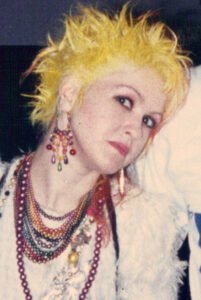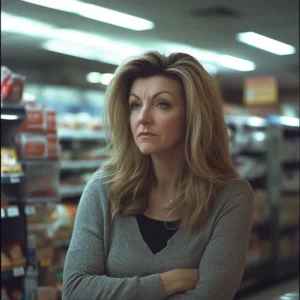There’s something magical about Cyndi Lauper, the lively artist behind the 1983 hit “Girls Just Want to Have Fun,” a song that quickly became a global anthem, encouraging women everywhere to embrace fun and freedom.
Lauper is the definition of cool. Her quirky, carefree personality, playful fashion, and colorful hair inspire people with her message to always be yourself.
However, behind the playful voice that spreads joy to her listeners, Lauper battles a severe skin condition called psoriasis. At one point, it was so intense that, as she described, “It looked like someone threw boiling water on me.”

Wire Image
The legendary pop star, now 69, recently opened up about her ongoing battle with psoriasis—a chronic skin condition that has no cure—since she was first diagnosed in 2010.
Psoriasis can cause severe pain, itching, discomfort, and rough, scaly patches on the skin. About 8 million people in the U.S. and 125 million globally live with this condition.
Lauper’s symptoms started as scalp irritation and general discomfort, which worsened over time.
Initially, she thought her itchy scalp was from frequently coloring her hair, but the symptoms continued, causing both physical pain and emotional strain for the award-winning musician.
The “Time after Time” singer is a busy mother, touring pop star, and activist.
Inspired by her sister Ellen, who is a lesbian, Lauper has become a strong supporter of LGBT rights, working tirelessly to advocate for the community.

Her 2005 song “Above the Clouds” was written in honor of Matthew Shepard, a 21-year-old gay student who was beaten to death in Wyoming. Lauper also started the “True Colors” concert tour in 2007-2008, which raises support for local and private LGBT charities and organizations.
Besides her advocacy, Lauper has an impressive career as a singer, songwriter, and actor. Over the past forty years, she has received many awards, including a Tony Award, two Grammy Awards, an MTV Music Video Award, and an Emmy Award for her role in a 1995 episode of the TV show *Mad About You*.
She also has a star on the Hollywood Walk of Fame, is a member of the Songwriters Hall of Fame, and in 2013, her humanitarian work earned her a special invitation to attend President Barack Obama’s second inauguration.
Despite her diagnosis, Lauper continues to stay strong. She is committed to not letting psoriasis hold her back and works on managing stress to avoid triggering flare-ups.

When she was first diagnosed and dealing with severe psoriasis, Lauper wrote the music and lyrics for the Broadway musical *Kinky Boots*, which won her a Tony Award for Best Original Score. She became the first woman to win a Tony in that category on her own. The show also won five more Tony Awards, including Best New Musical.
In a conversation with the American Academy of Dermatology (AAD), Lauper openly shared her experience living with the autoimmune skin condition, hoping her story might help others.
“I’ve never been able to really manage stress,” she admitted, explaining that she now takes a holistic approach to healing and stress relief both at home and on the road. She learned reiki, a Japanese technique for relaxation, saying, “That helps me.”
Along with reiki, Lauper works to stay grounded by meditating, practicing yoga, or taking walks in the fresh air with her dog and her husband, David Thornton, whom she married in 1991. The couple has one son, born in 1997.

“It’s not a bad thing to take care of yourself,” Lauper said, urging people to always “make a little time for you.”
She encourages starting small. “How about five minutes for you?” she added.
Lauper speaks with resilience about her experience, explaining that “when psoriasis gets really bad, it’s really hard to get up again.” She shared that at times, she couldn’t regulate her body temperature, leading to chills that could result in hypothermia. Even when resting, her condition only worsened, and hearing people dismiss it as “just a rash” added to her struggles.
“You don’t have to suffer,” Lauper said. Treatments, such as topical and oral medication or injections, can help ease the often unbearable symptoms of psoriasis. For Lauper, she found relief with Novartis’ Cosentyx, and as a spokesperson for the medication, she happily shares that she’s been “four years clear.”

In 2017, Lauper spoke with HealthDay about managing her psoriasis.
“It’s funny—you start wearing gloves, or this and that, hoping [psoriasis] is invisible, but it’s not. I didn’t show it off, like, ‘Woo-hoo, check this out!’ Doesn’t everyone try to hide it? You’d be surprised how many people have it and don’t talk about it. It’s one of those invisible things, so it’s good to talk about it.”
She shares more about it on her podcast *PsO in the Know*, where she talks with celebrities, advocates, and everyday people who offer insights on living with psoriasis.
The show is now in its third season and is available on Apple Podcasts, Spotify, Google Podcasts, Pandora, and Stitcher.
Lauper isn’t the only celebrity with psoriasis. Kim Kardashian, now 42, was diagnosed at 30 and is open about her challenges. Her mom, Kris Jenner, 67, had her first outbreak in her late 20s and said it was “life-changing.” Other celebrities with psoriasis include musician Art Garfunkel, 81, actor Jon Lovitz, 65, and Jerry Mathers, 74, known as “The Beaver.”
I Found a Little Girl in My Shopping Cart—Her Plea Changed My Life Forever
I was doing my usual grocery shopping when I suddenly found a little girl sitting in my cart. She looked up at me with big, scared eyes and whispered, “Don’t give me back, I’m scared.” At that moment, I knew my life was about to change.
My career was steady, and my life was well-organized. I took pride in the independence I had built over the years. Being single didn’t bother me. I enjoyed the freedom and simplicity of my life, without many responsibilities beyond my job and daily routine.

My daily routines, though simple, brought me comfort. After my sister Melissa lost her job, I let her stay with me. She was family, after all. She had a tendency to take control of things, but I hoped she’d get back on her feet soon.
That day started like any other. I went grocery shopping, as I did every week. The simple act of shopping made me feel in control.

Walking through the aisles, I focused on my list. Halfway through, I turned to grab a box of cereal, and when I looked back at my cart, there was… a little girl!
She was sitting in the basket. I blinked, confused.
“Hi! Where’s your mommy?” I asked.
“I don’t know,” she whispered, gripping the cart tightly.
I froze, trying to understand what was happening. I looked around, expecting to see a parent nearby, but there was no one.

“What’s your name?” I asked gently, crouching to her level.
“Lily,” she whispered softly.
I looked around again, but the store was full of busy strangers. What should I do? Leave her and wait for someone? But what if no one came?
“Well, Lily,” I said softly, “let’s find someone who can help us, okay?”
I slowly pushed the cart, scanning the aisles for her parents. After 20 minutes, it was clear—no one was coming for her.

Just as I was about to call the police, she looked up at me with tear-filled eyes and whispered, “Don’t give me back, I’m scared.”
Before I knew it, I had taken her home.
Everything felt surreal. Lily, a scared little girl, sat at my kitchen table, eating a sandwich, her eyes following me as if I was her only safety.
The front door opened, and Melissa walked in. I knew this wouldn’t go over well.
“What is this?” she asked, her eyes locking on Lily.

“I found her at the grocery store,” I explained, trying to stay calm.
“Found her?!” Melissa exclaimed. “You can’t just bring home a child! Do you even know where she came from?”
“No, but she was alone,” I replied. “I couldn’t leave her there.”
“You can’t fix everything, Rachel. This is a bad idea.”
“I called James,” I said, mentioning my detective friend. “He’s looking into it. We’ll figure it out.”
Melissa sighed in frustration but muttered nothing else. My focus stayed on Lily.

The next morning, my fears came true. There was a knock at the door. Social services had arrived.
Melissa acted fast, as she always did when worried. I knew I couldn’t keep Lily, no matter how much I wanted to.
“We’ll take her into care,” a social worker said gently.
I looked at Lily, who was clutching the table.
“I… I just need a minute,” I stammered.

I knelt by Lily. “Sweetie, you have to go with them for now. They’re going to help you.”
Her big eyes met mine. “Please, don’t give me back. I’m scared.”
Her words broke my heart, but before I could say more, the social workers took her away.
Suddenly, my phone rang. It was James, his voice serious.
“Rachel, I found something. Her name’s Lily. She’s run away from home before, but they’ve never found anything wrong.”
“Do you have their address? Send it to me, please.”

Later, Melissa began criticizing me again. “This is why I called social services. You’re acting impulsively.”
“A mess? You think this is a mess?” I snapped. “Lily needed help, and I wasn’t going to abandon her. Maybe focus on your own life before judging mine.”
Melissa stayed silent. I grabbed my keys and left, determined to figure things out.
When I arrived at Lily’s house, something felt off. The house was neglected, the yard overgrown. I knocked, and a pale woman opened the door—Lily’s mother, Gloria.
“I’m Rachel. I’ve been caring for Lily,” I explained.

At her daughter’s name, Gloria’s expression filled with sadness. She let me in.
“I know I can’t take care of her anymore,” Gloria admitted, her voice heavy with defeat.
“Gloria,” I said gently, “you love her, but she needs more right now. Let me help.”
Gloria wiped her eyes. “I tried… after her father died.”
“You don’t have to do this alone. I’ll care for her while you get back on your feet. We’ll figure this out together.”
“You’d do that?” she asked.
“Yes. Lily needs to be safe. I’ll take care of her for now, and when you’re ready, she can come back.”
Gloria nodded, and we talked about a plan for her to visit Lily and work toward getting her back.
Just then, social services arrived. Lily ran to her mother, hugging her tightly.
“I’m here, baby,” Gloria whispered. After a few moments, Lily walked back to me.
I spoke with social workers and Gloria about the plan. Lily would stay with me temporarily, and we would reassess Gloria’s situation in a few months.
“It’s time to go, sweetie,” I said, holding Lily’s hand.
Gloria gave her a nod. “Be good, okay?”
From that day on, life changed for both of us. Lily adjusted, and we found comfort in new routines.
One night, she asked, “Will I see Mom again?”
“Yes, sweetie,” I assured her. “When she’s ready. And until then, you’re safe here.”
Through this journey, I learned that love sometimes means knowing when to let go and trust in the future.



Leave a Reply